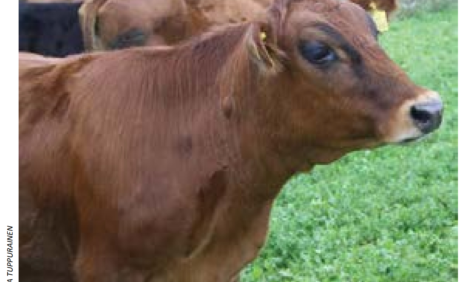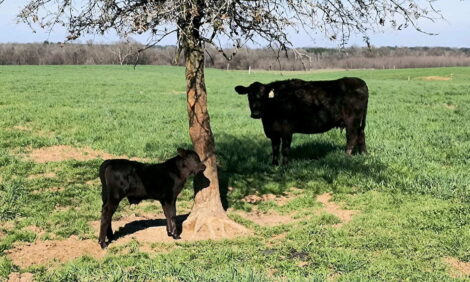



Success With Sexed Semen
Sexed semen has been operating for over 10 years. Charlotte Johnston, The CattleSite junior editor speaks with Hugh Pocock from Cogent UK to find out how it works and what the benefits are.Cogent introduced the idea of sexed semen to the world in 1997, bringing technology from the US to the UK and putting it into practical use. The first calves to sexed semen straws were born in 1999.
Since then the technology has been constantly improving and its popularity, particularly amongst dairy producers has been increasing. However the benefits can be seen for beef and dairy producers alike.
Hugh Pocock, UK sales and genetics manager for Cogent says there are a number of benefits when using sexed semen. These include:
Easier calving: Bull calves are generally more difficult to calf, says Mr Pocock. With an increased chance of producing a heifer calf there will be less stress at calving time on the cow. This is particularly useful for maiden heifers.
With calving easier, Mr Pocock says the heifer will have a better chance at focusing on settling into the milking herd - which is much bigger than what she is used too. This is likely to result in a higher yield as the cow is under less stress. With an easy calving the cow is also less likely to have future fertility problems caused by difficult calvings.
Genetic gains: Producers try to breed from the best cows, but if these cows produce bull calves, they will take heifer calves from the poorer cows as herd replacements. Sexed semen allows producers to target their best cows and in return breed the best replacements.
Increase herd size: Sexed semen gives producers the opportunity to breed replacements for the herd without having to spend large amounts of money on heifers and avoid the associated risks of bringing replacements onto the farm.
Income diversification: There are two aspects to this - the first is breeding heifers to sell on the open market. The alternative is that the producer can use sexed semen on the top half of his herd to produce replacement heifers and put the remainder of his herd to a beef bull to produce calves that are worth more on the beef market.
How does it work?
There are no apparent differences between female and male sperm cells. The only difference is that the female cells contain 3.8 per cent more DNA. A dye is added to the semen which is absorbed. The fluid is then run through a flow cytometer and a laser identifies droplets of female sperm (which glow brighter with the dye). A negative magnetic charge is then applied to the desired cells which are subsequently separated and frozen in straws.
Cogent are the only firm in the UK that sex semen.
Semen is collected from bulls at 12 months of age, however it is not until five years later until a true representation of bull quality can be seen through offspring confirmation, yields etc.
Out of all bulls Cogent buy only 1 out of 10 are used. A positive transfer ability (PTA) is probably 35 per cent reliable, however once a bull has produced offspring their PTA becomes 80 per cent reliable says Mr Pocock.
Accuracy
On average a female sperm straw contains 90 per cent female sperm. However Mr Pocock says that this is constantly improving with research carried out.
Conventional methods would result in 50 per cent chance of a heifer calf been born, sexed semen results in a 90 per cent chance of a heifer calf been born.
Conception rates are between 55-70 per cent plus.
Cost
An average conventional straws costs on average £15, the cost of a sexed semen straw could range between £25-45.
Mr Pocock recommends using sexed semen as a management tool to breed off maiden heifers and the top per cent of the herd. By doing this and then crossing other cows to beef breeds, the use of sexed semen pays for itself through herd health, yields and calf returns.
Tips to success
Mr Pocock says that cows selected to be used with sexed semen should either be maiden heifers (who have the highest change of conceiving), and cows with a healthy history. Cows that have had mastitis, held cleansings or lameness should not be served with sexed semen.
Management pre-service is vital to success. Animals, particularly heifers should be moved into small groups to reduce stress and help settle them.
Cows should also have a consistent diet, nutritionally balanced for energy, protein and minerals. Cogent recommends that no changes should be made to diet one month before and one month after service.
The handling of sexed semen must be done delicately, says Mr Pocock. Straws should never be handled by fingers but always with tweezers. Taking individual straws out and then returning them is also likely to damage the sperm. He also recommends minimising the amount of time (no longer than five seconds) that a straw container is kept above liquid nitrogen level whilst removing individual straws.
- Check the temperature of the water in your thawing device with a thermometer.
- Only remove one straw at a time for thawing.
- Flick the straw to remove any trapped nitrogen.
- Thaw the straw straight away in an electric thawer at 37 oC for 40 seconds.
- Thoroughly dry the straw, water kills sperm.
- Use clean straw cutters, or sharp scissors to cut off the sealed end.
- Once thawed don't let the straw cool down again.
- Pre-warm the AI equipment and keep it insulated until the insemination (especially in cold weather).
- Animals should be inseminated within five minutes of removing from the tank.
- Once thawed straws cannot be re-thawed.
- Do not split straws.
Service time
Heifers/ cows should be observed at least three times daily for at least 15 minutes especially in between milking and feeding times.
Record standing heats accurately to verify regular oestrus cycle length. Those with abnormal cycle length will be less fertile.
Other signs of oestrus such as mounting are less reliable and less valuable semen should be used to serve those animals. Heat detection aids such as tail paint and other detection aids are important in identifying cows in heat.
Finally Cogent say that a proper service area and crush are essential. Animals must be handled quietly and in small groups or pairs.


